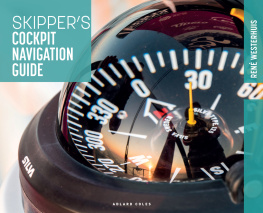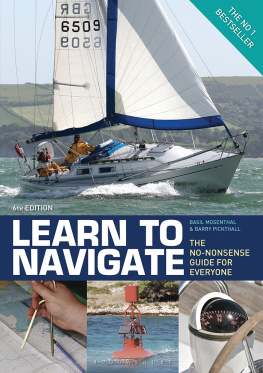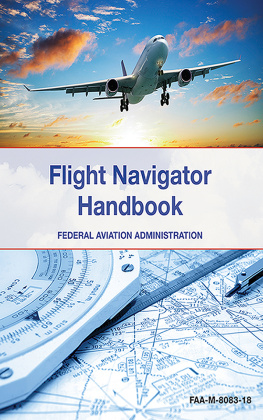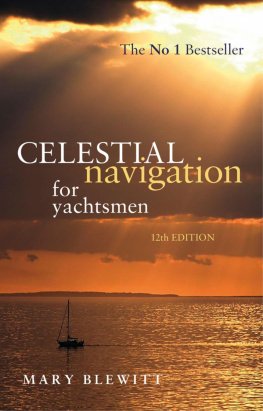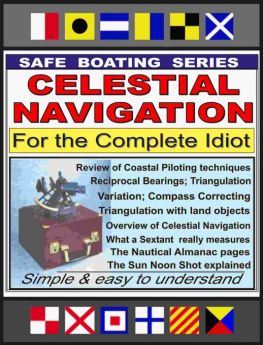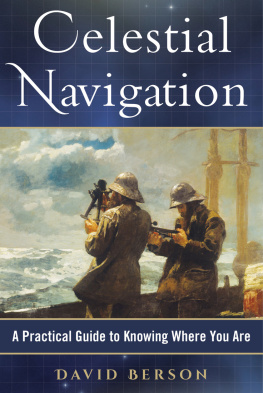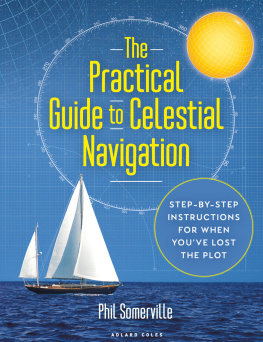Celestial Navigation
in a Nutshell
Celestial Navigation in a Nutshell
Hewitt Schlereth

First published 2000 by
Sheridan House Inc.
145 Palisade Street
Dobbs Ferry, NY 10522
www.sheridanhouse.com
Copyright 2000 by Hewitt Schlereth
Fourth reprint 2010
All rights reserved. No part of this publication may be reproduced, stored in a retrieval system or transmitted in any form or by any means, electronic, mechanical, photocopying, recording, or otherwise, without the prior permission in writing of Sheridan House.
While all reasonable care has been taken in the publication of this book, the publisher takes no responsibility for the use of the methods or products described in the book.
Library of Congress Cataloging-in-Publication Data
Schlereth, Hewitt.
Celestial navigation in a nutshell / Hewitt Schlereth
p. cm.
Includes index.
ISBN 978-1-57409-058-1 (alk. paper)
1. Nautical astronomy. I. Title.
VK555.S339 2000
527dc21
99-049975
CIP
Editor: Catherine Degnon
Production Management: Quantum Publishing Services, LLC, Bellingham, WA
Composition Design: Jill Mathews
ISBN 978-1-57409-058-1
Printed in the United States of America
Contents
Why celestial navigation? In this, the day of the hand-held GPS when the hand-held sextant is often regarded as some antiquated artifact, the usual answer to the question is that celestial is a nice backup. This quaint old art, it is argued, does not depend on batteries or fragile circuits or what is euphemistically called selective availability (which seems to mean, The satellite can be turned off). These are sound, practical reasons, to be sure. And true. But they arent quite it, are they? There is something more to celestial than plain old utility.
Think back: From just about the first moment you set foot on a boat you heard two things talked of in hushed tones; Cape Horn, and celestial navigation. With the passage of time you likely as not came to see the Horn as the mariners Everest and celestial as one of the higher Alps. At this stage you may not be dreaming about the Great Cape any more. But, hey, theres still the Matterhorn.
Why learn celestial navigation?
Because it will satisfy your soul.
I have often thought that if a pagan could be a saint, Ariadne would be the patron saint of navigators. When she handed the end of that skein of twine to Theseus as he entered the maze to find the Minotaur, she not only found the key to a labyrinth, she also hit upon the fundamental principle of navigation: If you know your way back, you are not lost. Taking her precept a step further, to navigate at sea you not only attach a thread to your starting point, you also keep track of the amount you pay out and take note of any twists or turns you happen to make.
What I am talking about here, of course, is what is customarily called DR navigationknowing where you are by the dead-simple practice of keeping an account of the courses steered and distances run from a known departure point and not breaking the thread until another known point is established.
So, contrary to general belief, you do not begin navigating by first getting lost. Thats the way Theseus would have done it. You know where you are because you know where you started from, the direction you went, the speed you went, and the length of time you went. It takes only the most basic application of arithmetic and common sense to pause now and then, lay out the course and distance on a chart, and mark the spotyour position by deduced reckoning, or what some refer to as dead reckoning. Most often, however, this position is called simply called the DR.
Heres the point. Navigation, taken as a whole, has two steps: (1) keeping the DR, and (2) periodically checking it by other means. In reality, navigation is a process of the one checking the other. Its extremely risky to leave out either step. Wheres your check then?
Nowadays, if you are on a passage and using GPS and celestial in addition to your DR, a normal spread between the GPS, celestial, and DR positions soon emerges. Any sudden changea celestial or GPS fix twice its usual distance from the DR, for examplemeans something is out of whack with the celestial or GPS. Should you lose celestial to bad weather or GPS to accident or selective availability, you will by then have acquired a sure sense of your DR and can carry on with it until the weather clears or the satellites are back on.
Whatever you do, never give up the DR.
Part I

Our Star: Navigation by the Sun
The Big Picture
If navigation as a whole has two steps, celestial navigation has four:
1. Taking a sight with a sextant
2. Establishing a secondary reference, or benchmark, sight
3. Comparing the two sights
4. Putting the result of the comparison on a chart
Virtually everyone is familiar with the first sight, the so-called shot of the sun. Thats where the navigator puts his or her eye to the telescope of a spindly black instrument, aims the contraption at the sun, twiddles a knob on its lower edge, and hollers mark to a crewmember hovering nearby with watch, pencil, and notebook to jot down the exact time the sun in the navigators telescope touches the rim of the sea.
What virtually no one except the navigator is familiar with is the second sightthe one used as a benchmark for comparison with the first. The navigator generates this sight either by thumbing through a succession of books whose entire contents are rows and columns of numbers set in the tiniest type or by punching numbers into a pocket computer. This mathematically derived reference sight is what navigators talk about when they get together, because it is the sine qua non of modern celestial navigation and there are so many ways to get it, varying from the ridiculously easy to the absurdly arcane.
Taking the first sight is easy. Learning to use a sextant is a lot like learning to shoot a rifle, and the obvious analogy is the reason sights are usually called shots. Everyone learns to use a sextant very well, very quickly.
The benchmark sight, on the other hand, is what makes learning celestial difficult. Its not the concept; thats straightforward. The difficulties lie in the materials: the books of columns of numbers, the work forms, and the rigid protocols of pocket computers and calculators. For me, learning my way around the columns of figures and work forms was a lot like learning to dance the Charleston; I simply had to go through the steps many, many times before they finally became automatic. The process is the same for everyone. You can read about celestial navigation till the cows come home, but you wont learn it until you
Next page

